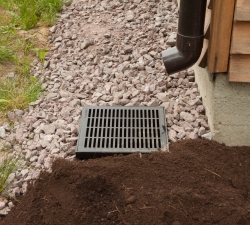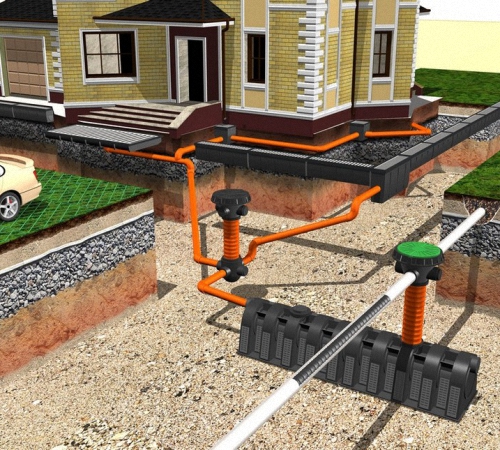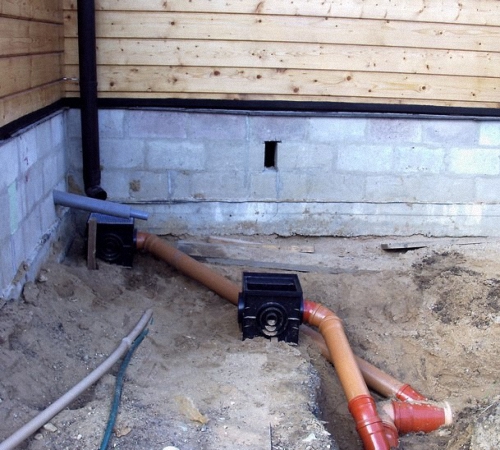The decoration of residential premises is the final stage of construction. Everyone knows,...
|
|
During repair planning in the apartment, we always want to make our nest ... |
Interior designers often turn to ethnic roots, because everything is in fashion ... |
Livne sewage device. Calculation, installation, maintenance

Puddles during the rain are not uncommon to get rid of them, and it is recommended to equip a storm sewer to prevent flooding in a private house. How to design a storm sewer with your own hands will try to figure it out.
Table of contents:
- General concept of storm sewer
- The main types of storm sewers
- Varieties of drainage of storm sewers
- Installation of an open -type storm sewer
- Closed storm sewers: design
- Device and storm sewer diagram
- Preparatory work
- The cost of the installation of storm sewers
- Livne sewage service
General concept of storm sewer
Livne or rain sewage - these set of water pipes, filters and devices for driving water from a site of a residential building.
The main components of the rain sewage system:
- Sand separators;
- well or collector;
- oil or gasoline filters;
- absorbent block.
The sewage of the storm type performs the function of drainage of water from the site. To perform this function, the presence is necessary:
- rain receivers;
- drainage gutters;
- germs.

In addition to water drainage, rain sewage performs the function of filtering water from sand and other pollutants using filtering components. Pure water enters the general sewer in a purified form.
Additional functions of the rain system:
- Watering plants in a personal plot - melt water positively affects the growth and development of plants;
- Improving the strength and durability of the building - the storm system prevents the flooding of the building, thus protects the structure from mold, fungus and moisture;
- purification of water from sand and other impurities;
- preservation of the integrity of sidewalks, pedestrian paths and blindings of the building;
- reducing the risk of water entering the basement or base of the building;
- The exclusion of the formation of puddles and dirt during precipitation falls.
The main types of storm sewers
Livne sewage is divided into:
- open,
- closed,
- Combined.
Livne sewer photo:

Open storm sewer is the easiest and cheapest in the arrangement. This is a system of gutters that are located on the roof. Water flows through the gutters, and is driven away from the site, along special grooves that are not covered by anything. Scope of use: settlements where a small number of population lives.
A closed storm sewer is a more complex type of sewage system, which requires the installation of not only gutters, but also underground pipes and rain intakes. Water is assembled according to the whole system into wells, cleaned, and then removed from the site or used for other purposes. Application: large settlements, private territories.
Combined storm sewers are designed in large areas, where it is necessary to reduce costs for the cost of a closed storm system.
Varieties of drainage of storm sewers
- The storm drainage of the point type is performed in the presence of local drainage, such as the receivers-receivers. Water is collected for one site or in one item. Such a system includes: drain pipes or taps, a removable lattice, filters, and an underground sewer system.
- Livine drainage of a linear type - designed to drain water from a large area. The linear system includes: linear drainage and sand cleaners in the form of a basket, which should be periodically cleaned.

Installation of an open -type storm sewer
The storm sewer is also called linear, because water gradually flows through the roofs in a designated place. When water flowing into the gutters in special trays, which are at the end of the gutter, the storm sewers are called open.
To install an open sewage system, a gutter is used that are:
- metal,
- concrete,
- plastic.
To protect the sewer from pollution, gratings are put on the gutter, which perform an aesthetic function.
To prevent soil shrinkage, the channels under the grooves are made with a slope. For the arrangement of channels, waterproof sealants are used.

Tips for the arrangement of an open -type storm sewer:
- When arranging an open sewage storm should not be limited only to gutters, be sure to provide for the drainage system. If you install only water collectors and gutter, water will drain on the surface that is near the house, and this will significantly affect the foundation and provoke dampness and mold.
- Preventive cleaning of storm sewers should be carried out at least once a year, to prevent the formation of blockages in rainers and trays with hoses.
- Use only high -quality sealants when installing storm sewers to provide high quality rain system.
Closed storm sewers: design
Before the design of a closed -type storm sewer, it is necessary to prepare the following documents:
- preliminary drawings and information about the project;
- sewage scheme;
- Work report.

To make the correct calculation of the storm sewer, find out:
- characteristics of the territory and landscape features;
- the presence of architectural buildings;
- average precipitation;
- Placement of technical structures.
In preliminary drawings, indicate the location of the pipes, the places where rainers, trays and gutter, observation decks and a collector will install.
Device and storm sewer diagram
For work, you will need:
- gutter,
- rain receivers,
- shameful pallets;
- gutters and trays;
- pipes;
- observation wells;
- Sandlipers.

The main component of the storm sewer system is the drain that collects all the water. No less than the main element is the rain receiver, according to which water enters the drain.
The receiving well performs the function of absorption of water, which comes from the rain receiver.
To cleanse water from precipitation, sand and dirt, there are sand traps in which water falls before draining into the sewer.
To control and clean the storm system, viewing wells are installed.
Preparatory work
- Use waterproof, anti -corrosion materials when working on storm sewers. In a storm sewer, corrugated pipes are quickly clogged, so do not use them.
- Avoid complex schemes in determining the location of the pipes. Place pipes without additional turns and a turn. All structural parts must be hermetically connected.
- The slope of the storm sewer and all the pipes are directed to the side where the water collector is located. Follow the angle of inclination to avoid freezing of water in the rain receivers.
- After the installation circuit is ready, the meter of the pipes and all the necessary elements should be calculated.
- To protect the rain sewage system, special grilles are used from garbage.
- If the sewage area is large, install one or two additional wells for additional cleaning.
- When installing rain sewage, PVC or asbestos -cement pipes should be used. You need to clean the pipes with a metal cable.

Laying sewer gasket:
Consider the installation of gutters on the roof:
- Make holes for installing rain receivers. Install the devices and seal all the joints.
- Install the pipes responsible for the flow of water.
- All devices are attached to the wall and roof of the house with clamps.
Instructions for the device of internal storm sewers:
- After approval of the installation scheme, the marking of the territory should be made and preliminary places of installation of the sewage system should be indicated.
- Dig ditches, the bottom of which should be tamped and filled with sand 15-2 ° C. If necessary, insulate the trenches with geotextiles.
- For the collector, prepare the pit. Dig a hole and pour concrete using metal rings or plastic container.
- The pit is also made by installing a factory well in a pre -prepared hole.
- To facilitate the work on the sewer, apply plastic pipes and fittings for connection.
- In pre -dug trenches, lay the pipes and combine with the collector and trays.
- The observation well is located for every five meters of sewage.
- At the absence of a rain recreation, the installation of a gutter should be installed, which is covered with a lattice.
- Between the tray and the gutter, place the sand cleaner. This should be done so that the water is already cleaned into the system.
- Seal all joints and connections.
- After collecting the entire system, the system should be tested. Fill the rain receiver with water and follow the operation of the sewage system and the tightness of the connections.

Tips for the installation of storm sewers:
- Use pvc pipes with a storm sewer diameter of 110 mm, and a double coupling connection;
- The depth of sewage laying depends on the strength of the pipes, the stronger the pipe, the greater the depth of the laying;
- If there is a drainage system on the site, a storm sewer should be laid above this system;
- With a low depth of storm sewer, the pipes should be insulated using geotextiles and crushed stone;
- The storm sewers in a private house are connected to the water system or to watering a summer cottage;
- If there is a reservoir near the site, you should not install a collector, equip the system so that water gets into the reservoir;
- If the storm sewer passes at the site of the car’s travel, use iron grilles that can withstand heavy loads.
The cost of the installation of storm sewers
The cost of arranging storm sewers depends on the depth of pipe laying, the number of rain receivers and the total area of \u200b\u200bthe site. Live sewage price the price of $ 28 per 1 m with the number of rainers, which does not exceed 15 pieces and with a fine depth of laying up to one meter.
At a sewage depth of 1 to 1.6 m with 15 rain receivers, the cost is $ 71 per 1 m. The installation of additional rain receiver is $ 61.
Livne sewage service
Ways to clean the storm sewer:
- mechanical - by removing all pollution, sand and traffic jams;
- water - the use of a water jet that breaks through the corks;
- thermal - use for cleaning water sewage with high temperature;
- Chemical - sewage cleaning with reagents.

To clean the external system, which is located on the roof, use a mechanical method. To do this, examine the gutter and rain intakes and remove the garbage.
Water intakes are cleaned with the water method: a stream of water is directed to the lattices under large pressure.
The cleaning of the open type system includes:
- extracting the gratings that close the trays;
- cleaning of the channels from garbage;
- flushing the channels with water;
- Installation of gratings.
Cleaning closed storm sewers:
- Use a stream of water under a large pressure exceeding 35O bar;
- To improve the quality of cleaning, water should be served in two directions: to the collector and vice versa;
It is quite possible to clean the storm sewers yourself if the diameter of the pipes does not exceed 200 mm. In another case, a special technique is needed, which easily cope with the cleaning of such a system.
If it is necessary to attract specialists, the following actions should be performed:
- learn about the probability of using heavy equipment;
- when confirmed by this fact, prepare a site for travel or installation of equipment;
- Clean access to storm sewers.
